Home
Philippus I
Marcus Iulius Philippus, Roman emperor from 244-249, is also known under the name of Philip the Arab because he came from the province of Arabia. He was born in the town of Shahba in the southern part of Syria as the son of Julius Marinus. His brother Julius Priscus was the second Praetorian prefect next to Timesitheus, the father in law of Gordian III. When Timesitheus died, according to some ancient writers as a result of a murderous plot by Philip and Priscus, the latter managed to get his brother elevated to the rank of Praetorian prefect. According to some ancient writers both brothers tried to depose of the young emperor Gordian III resulting in the death of the latter. The ancient writers however were very hostile towards Philip and the stories about the murder plots could probably have been manufactured. Timesitheus probably died as the result of some disease and the young emperor Gordian probably died as a result of a fall from his horse during a battle against the Persians (read the part about the emperor Gordian for more information). In the so called 'Res Gestae Divi Saporis' Shapur I of Persia describes the events surrounding the elevation of Philip as follows: 'Gordian Caesar was killed and the Roman army destroyed. And the Romans made Philip Caesar. Then Philip Caesar came to us to negotiate and as a ransom for their lives he gave us 500,000 denars and became tributary to us. For this reason we renamed Misikhe in Peroz-Shapur'. So once made emperor by the army, Philip bought the piece with Shapur for a great sum of money in order to get safely back to Rome. On some early coins of Antioch and Viminacium Philip is called Persicus Maximus (PM), the greatest conquerer of the Persians. Soon this title dissapeared from the coins because in fact the peace with Shapur was bought with a great sum of money.
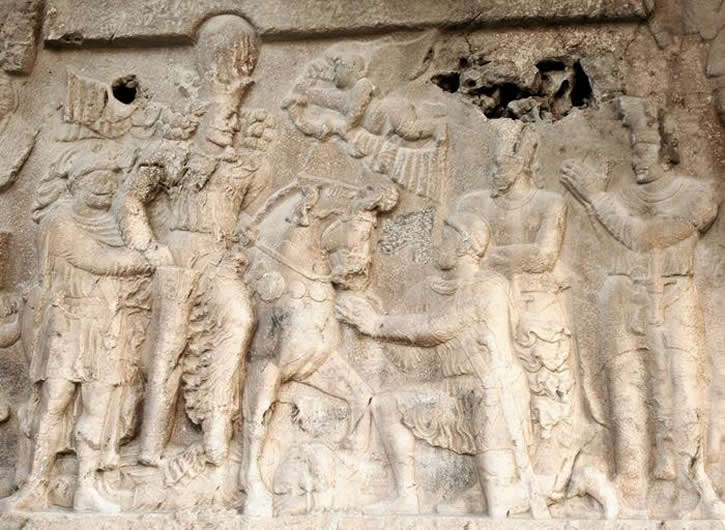 |
|
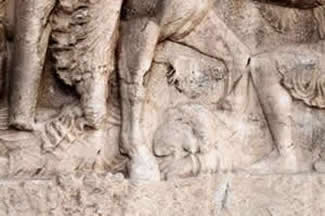 |
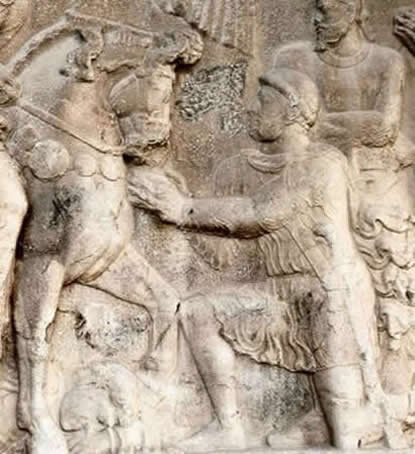 |
| Relief from Bishapur in Iran. Some scholars say that this image shows Shapur I on horseback. Underneath the horse the dead body of Gordian III is visible. Before the king is an image of a kneeling figure representing the emperor Philip. He is negotiating a piece and a save withdrawal for the remnants of the Roman army. The man whose wrist Shapur is holding represents the later emperor Valerian whom he captured with his own hands. In this way the image shows multiple highlights from Shapurs career. | |
It is highly probable that Philip made an agreement with Shapur concerning Armenia and allow the Persians to occupy Armenia (Dignas & Winter, 2007). The so called tributes that Shapur is talking about are probably the payments Rome made to the Armenian vazal state to guard the Kaukasus borders. Because of the new agreement the payments went to Shapur because the Persians were ruling Armenia. When Philip left for Rome he left his brother Priscus in control of the eastern provinces as rector Orientis and in command of the legions. He appointed his brother in law, Severianus governor of Moesia to defend and control the Danube frontier. Philip elevated his six year old son to the rank of Caesar in the summer of 244 and to the rank of Augustus in 247, probably in august. During the reign of Philip the 1000th aniversary of the foundation of the city of Rome was celebrated. The Romans normaly did not use a year notation but named the years after the consuls who held office in a particular year. The consular year began on the 1st of january. If a year count was used at all it was the counting of the years after the foundation of the city of Rome. According to the 3th century 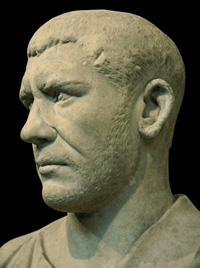 writer Censorinus the Roman year began on april 21 an ended on april 20 the following year. The Roman year 1000 according to the calculations of Varro, a Roman scientist from the time of Julius Caesar, went from 21 april 247 until 20 april 248. Shortly after the festivities problems started in the Balkan provinces and in the east. Discontent about the military results along the Danube frontier the usurper Pacatian was elevated to the rank of Augustus by the troops, probably around the autumn of 248. This is probably the main reason why Viminacium coins of the local year 10 (248-249) do not exist. The lack of coins of the local year 10 can also support the theory of Prof. Alfoldi who stated that the Viminacium mint which was responsible for the copper and brass coins did not mint coins troughout the whole year but only had certain periods of minting. During the beginning of the local year 10 there probably was a coinage of antoniniani in the name of Philip. The year 10 then became disturbed by the usurpation of Pacatian. It has been stated that the coinage of antoniniani at Viminacium started during the revolt of Pacatian but there probably were small emissions of antoniniani struck in the name of Philip during the years 246 and 247. In those years hard cash was necessary to pay the soldiers involved in the wars against the Carpi.
writer Censorinus the Roman year began on april 21 an ended on april 20 the following year. The Roman year 1000 according to the calculations of Varro, a Roman scientist from the time of Julius Caesar, went from 21 april 247 until 20 april 248. Shortly after the festivities problems started in the Balkan provinces and in the east. Discontent about the military results along the Danube frontier the usurper Pacatian was elevated to the rank of Augustus by the troops, probably around the autumn of 248. This is probably the main reason why Viminacium coins of the local year 10 (248-249) do not exist. The lack of coins of the local year 10 can also support the theory of Prof. Alfoldi who stated that the Viminacium mint which was responsible for the copper and brass coins did not mint coins troughout the whole year but only had certain periods of minting. During the beginning of the local year 10 there probably was a coinage of antoniniani in the name of Philip. The year 10 then became disturbed by the usurpation of Pacatian. It has been stated that the coinage of antoniniani at Viminacium started during the revolt of Pacatian but there probably were small emissions of antoniniani struck in the name of Philip during the years 246 and 247. In those years hard cash was necessary to pay the soldiers involved in the wars against the Carpi.
Pacatian also needed money to finance his revolt. This is why he started a coinage of antoniniani to bribe the soldiers, with high probability those coins were struck in the mint of Viminacium. A type of antoninianus in the name of Pacatian exists with the reverse legend ROMAE AETER AN MIL ET PRIMO. This is a strong indication that his usurpation can be dated 'ab urbe condita - after the foundation of the city of Rome' between april 21 in the year 248 and april 20 in the year 249. In the east a revolt broke out against the government of Philips brother under the command of a man named Iotapian. Philips brother Priscus had become unpopular because of his excessive tax policy. Nothing more was heard of Priscus after the revolt so it is assumed that he died as a result of it. How the reign of these usurpers ended is not absolutely clear. Both men are supposed to be killed by their own soldiers. Other usurpers connected to the reign of Philip are one Silbannacus and Sponsianus. Only three coins are known struck in the name of Silbannacus. Different speculations and theories exist about his short reign. He supposedly was an usurper somewhere in Gaul but there was no mint during that time in Gaul, where then did he strike his coins? Another theory is that Silbannacus was an usurper during the beginning of the reign of Aemilian or Valerian. He supposedly was an accomplice of Aemilian who stayed behind in Rome while Aemilian himself went of to battle against Valerian. After Aemilian departed he forced the senat to raise him to the rank of Augustus and ordered to strike coins in his name. I used to think that Silbannacus held some power in Moesia Superior for only a short time right after the murder of Pacatian. In that case his coins could have been struck in the mint of Viminacium also, just like those of Pacatian. However in the chronicles of Michael the Syrian, Theodorus Skoutariotes and Constantine Porphyrogenitus, all of them mainly copying John Malalas, a certain Marius is mentioned. He supposed to have ruled for a short time after the death of the emperor Philip. Immediately after the death of Philip the senat supposedly elected Marius, nicknemed 'the frugal' as their emperor who ruled for x months (length of the rain is lost in the manuscript). Constantine Porphyrogenitus however mentions other details: 'Marius the emperor was killed by his wife while sleeping. He was not appointed by the senat but by the army who had put the senat asside in doing so'. On the coins the name and titles of Silbannacus are given as IMP MAR SILBANNACVS AVG so maybe he could have been the Marius whom the writers are talking about. His full name then was Marius Silbannacus. From the period of his very short reign only 3 coins have survived.
The life and reign of Sponsianus remains shrouded in mistery and coins in his name are denied as modern forgeries.
When the news of Pacatians revolt became known in Rome it is said that Philip became rather depressed and even offered the senat to resign. Senator and city prefect Messius Quintus Decius however predicted that revolts like that usually did not last long en were quickly resolved. He turned out to be right when Pacatian and after him possibly also Silbannacus were killed by their own troops. Philip was impressed by Decius and made him commander of the troops in Moesia and Pannonia to restore the order in the army. At first it seems that the regime of Philip was restored along the Danube because sestertii with the local year 11 (july 249 - july 250) in the name of Philip do exist. It is possible that these coins were struck in the period july/august 249. Shortly after that the troops forced Decius to usurp against Philip and take the purple. In sequence coins in his name with the local year 11 were struck in his name. There is however a theory that rebellious troops in Viminacium did not agree with the usurpation of Decius. They stayed loyal to Philip and did not want to remove the images of the emperor and his son from their army standards. During this revolt the coins with the local year 11 in the name of Philip are supposed to be struck. This oprising was supposedly struck down by one Clodius Celsinus who dedicated an inscription to this event.
After being elected emperor by the troops Decius went on his way to Rome, taking a part of the legions with him. The armies of Decius and Philip met near Verona in the autumn (probably september) of 249. In the following battle Philip died, it is however unknown how he died. Some historians say he died in battle but others say that he was killed by his own troops. After the news of the defeat of Philip reached Rome his young son Philip II was killed by the praetorians who then sided with Decius.
Literatuur:
Beate Dignas & Engelbert Winter, Rome and Persia in late antiquity; Neighbours and Rivals. Cambridge University Press 2007.
The coins of Philip from Viminacium
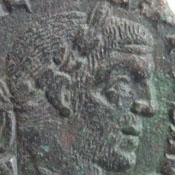 |
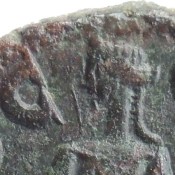 |
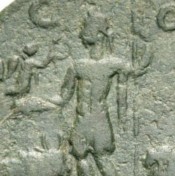 |
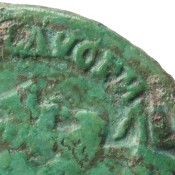 |
The coinage in the name of Philip was as abundant as the coinage of his predecessor Gordian. There are however few varieties or special reverse types. The few special reverse types are also rare or very rare. The coinage in the name of Philip started somewhere around february/march in the local year V (243/244). The portraits on the early coins do not yet resemble that of Philip but still have strong resemblance with the portraits of Gordian. It is not until late in the local year V that coins appear with a portrait of Philip that looks like the one that was used on the coins with the local years VI to VIIII. Around mid 247, somewhere in the transition from the local year VIII to the year VIIII, Philip made his young son Philip II his co-emperor. Because they both used the same name and titles it is sometimes hard to tell wich coins from the local year XI belong to Philip the elder and wich coins to his young son. This is because some sestertii exist from the local year XI with a portrait of a younger man. It could be an idealised portrait of the elder Philip or it could be his young son but the portrait looks to old for a boy who could not have been much older than 12 or 13.
The legends on Philips coins are also quite uniform. Only early in the local year V (243/244) a longer obverse text is used: IMP IVL PHILIPPVS PIVS FEL AVG PM. The abbreviation PM on these coins is not translated as the old fashioned and by this time obsolete Pontifex Maximus but as Persicus Maximus, the greatest conquerer of the Persians. As said earlier this type of legend disappeared rather soon from the coins because the so called peace with the Persians was bought with a lot of money. The text was soon changed into: IMP M IVL PHILIPPVS AVG and was used until Philips last year XI. Some very few examples exist with the very short obverse legend: IMP PHILIPPVS AVG. The examples i know myself and those mentioned in some literature are in a more or less worn state of preservation. Behrendt Pick for instance described some worn specimens wich according to him were from the local year III and IIII. This however is impossible because Philip only became emperor around february 244 and the local year in Viminacium at that time was the year V. Also the short obverse legend IMP PHILIPPVS AVG only appears for the first time on antoniniani somewhere during the middle of the year 247. The coins from Viminacium with this short obverse legend also must have been struck late in the local year VIII (246/247) but more probably during the local year VIIII (247/248). One example that i know of has a small diameter (21 mm) is thinner than an antoninianus and weighs only 3 grams. Because on this coin Philip is wearing a radiate crown the coin should be a dupondius but the weight is very low, even if the coin was meant to be an as.
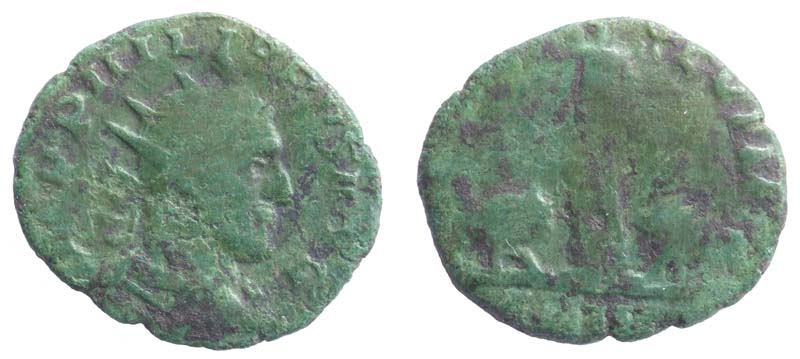 |
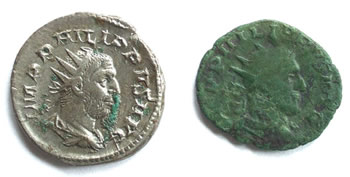 |
| IMP PHILIPPVS AVG - 21 mm and 3 grams. | The coin next to an antoninianus. |
A possible explanation for this type of coins could be that during the local year VIIII (247/248) there was some strange mixup of coin dies and a die meant for antoniniani in the name of Philip the elder was used in combination with a die for an as in the name of Philip II. Some researchers have stated that antoniniani were already minted in Viminacium before the usurper Pacatian took over in Viminacium. This coin could be some proof that this was really the case.
The denominations struck are: as, dupondius and sestertius.
The asses have a portrait with a laurel wreath while the dupondii have a portrait with the emperor wearing a radiate crown. The difference in weight between asses and dupondii is sometimes very small. Their difference in value probably came forth from the materials used. The sestertii in their turn are bigger and heavier and the emperor has a portrait with laurel wreath.
Used notations of the local year:
AN V, used from february/march 244 until july 244.
AN VI, used from july 244 until july 245.
AN VII, used from july 245 until july 246.
AN VIII, used from july 246 until july 247.
AN VIIII, used from july 247 until july 248.
AN X, nothing was struck.
AN XI, used from july 249 until august 249.
Obverse text variations used:
A: IMP IVL PHILIPPVS PIVS FEL AVG PM
B:
IMP IVL PHILIPPVS PIVS FEL AVG P
C: IMP M IVL PHILIPPVS AVG
D: IMP PHILIPPVS AVG
Reverse text variations used:
a: PMS - C - OLVIM
b: PMSC - OLVIM
c: PMS - C - O - LVIM
AN V |
|
| As ANNO V - 243/244 - Pick - - Martin - (Comp. 2.07) - Varbanov - (Comp. 140) | |
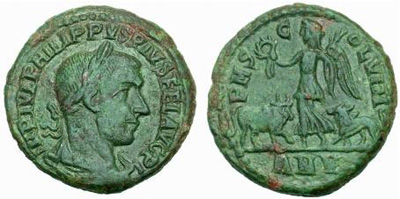 |
Weight: 8,32 grams Diameter: 24 mm |
Obverse: Bust of Philip I to the right with laurel wreath, part of paludamentum (cloak, cape) visible on the shoulder worn over armoured breast plate. Text: (A:) IMP IVL PHILIPPVS PIVS FEL AVG PM (IMPERATOR IVLIVS PHILIPPVS PIVS FELIX AVGVSTVS PERSICVS MAXIMVS) - Emperor Iulius Philippus dutiful and fortunate Augustus, greatest conquerer of the Persians. Reverse: Winged Victoria to the left holding a laurel wreath in the upright right hand. To her left a standing bull and to the right a lion. Tekst: (a:) PMS - C - OLVIM (PROVINCIA MOESIA SVPERIOR COLONIA VIMINACIVM) - Province Moesia Superior Colony Viminacium. Exergue: AN V (ANNO V) - year 5 (243/244). Remark: Extremely rare as of Philip. The obverse has the first type of legend wich ends with PM of Persicus Maximus. Later this title was removed from the coins because the victory over the Persians was bought at a high cost. The portrait of Philip on this coin still has some of the looks of Gordian III because the die cutters did not yet knew what the emperor looked like. The reverse with Victoria holding a laurel wreath is probably meant to celebrate the so called victory over the Persians. |
|
| Dupondius ANNO V - 243/244 - Pick 97 - Martin 2.05.3 - Varbanov 131 var. | |
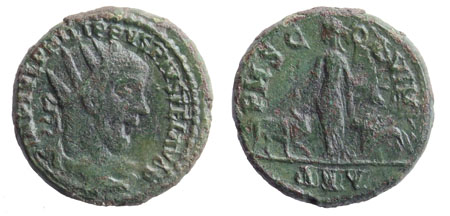 |
Private collection Weight: 7,97 grams Diameter: 22,7 mm |
Obverse: Bust of Philip I to the right with radiate crown, part of paludamentum (cloak, cape) visible on the shoulder worn over armoured breast plate. Text: (B:) IMP IVL PHILIPPVS PIVS FEL AVG P (IMPERATOR IVLIVS PHILIPPVS PIVS FELIX AVGVSTVS PERSICVS) - Emperor Iulius Philippus dutiful and fortunate Augustus, greatest conquerer of the Persians. Reverse: Woman (Moesia) standing with head to the left holding her right hand over a bull and her left hand over a lion. Text: (b:) PMSC - OLVIM (PROVINCIA MOESIA SVPERIOR COLONIA VIMINACIVM) - Province Moesia Superior Colony Viminacium. Exergue: AN V (ANNO V) - year 5 (243/244). Remark: The obverse on this coin has an other first type of legend wich ends only with the letter P of Persicus Maximus. Later this title was removed from the coins because the victory over the Persians was bought at a high cost. The portrait of Philip on this coin still has some of the looks of Gordian III because the die cutters did not yet knew what the emperor looked like. |
|
| Dupondius ANNO V - 243/244 - Pick 97 var. - Martin 2.05.1 - Varbanov 131 | |
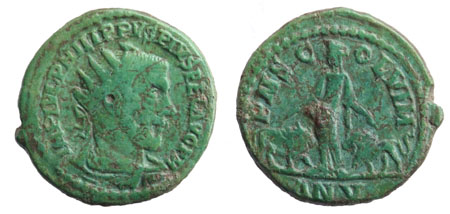 |
Private collection Weight: 6,56 grams Diameter: 23,6 mm |
Obverse: Bust of Philip I to the right with radiate crown, part of paludamentum (cloak, cape) visible on the shoulder worn over armoured breast plate. Text: (A:) IMP IVL PHILIPPVS PIVS FEL AVG PM (IMPERATOR IVLIVS PHILIPPVS PIVS FELIX AVGVSTVS PERSICVS MAXIMVS) - Emperor Iulius Philippus dutiful and fortunate Augustus, greatest conquerer of the Persians. Reverse: Woman (Moesia) standing with head to the left holding her right hand over a bull and her left hand over a lion. Text: (b:) PMSC - OLVIM (PROVINCIA MOESIA SVPERIOR COLONIA VIMINACIVM) - Province Moesia Superior Colony Viminacium. Exergue: AN V (ANNO V) - year 5 (243/244). Remark: The obverse has the first type of legend wich ends with PM of Persicus Maximus. Later this title was removed from the coins because the victory over the Persians was bought at a high cost. On this coin the portrait of Philip still has some of the looks of Gordian III. |
|
| Dupondius ANNO V - 243/244 - Pick 101 - Martin 2.11.1 - Varbanov 133 | |
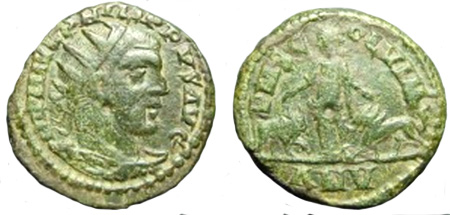 |
Weight: 9,40 grams Diameter: 24 mm |
Obverse: Bust of Philip I to the right with radiate crown, part of paludamentum (cloak, cape) visible on the shoulder worn over armoured breast plate. Text: (C:) IMP M IVL PHILIPPVS AVG (IMPERATOR MARCVS IVLIVS PHILIPPVS AVGVSTVS) - Emperor Marcus Iulius Philippus Augustus. Reverse: Woman (Moesia) standing with head to the left holding her right hand over a bull and her left hand over a lion. Text: (b:) PMSC - OLVIM (PROVINCIA MOESIA SVPERIOR COLONIA VIMINACIVM) - Province Moesia Superior Colony Viminacium. Exergue: AN V (ANNO V) - year 5 (243/244). Remark: This dupondius is from a later date in the year 5. The legend is of the shorter version, a letter M of Marcus is inserted but the text Pius Felix and Persicus Maximus is left out. The portrait looks more like that of Philip and like that on his later coins. |
|
| Sestertius ANNO V - 243/244 - Pick 96 - Martin 2.04.1 - Varbanov 130 | |
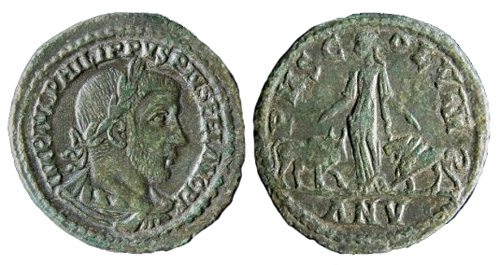 |
Weight: 16,04 grams Diameter: 30 mm |
Obverse: Bust of Philip I to the right with laurel wreath, part of paludamentum (cloak, cape) visible on the shoulder worn over armoured breast plate. Text: (A:) IMP IVL PHILIPPVS PIVS FEL AVG PM (IMPERATOR IVLIVS PHILIPPVS PIVS FELIX AVGVSTVS PERSICVS MAXIMVS) - Emperor Iulius Philippus dutiful and fortunate Augustus, greatest conquerer of the Persians. Reverse: Woman (Moesia) standing with head to the left holding her right hand over a bull and her left hand over a lion. Text: (a:) PMSC - OLVIM (PROVINCIA MOESIA SVPERIOR COLONIA VIMINACIVM) - Province Moesia Superior Colony Viminacium. Exergue: AN V (ANNO V) - year 5 (243/244). Remark: The obverse has the first type of legend wich ends with PM of Persicus Maximus. Later this title was removed from the coins because the victory over the Persians was bought at a high cost. The portrait of Philip on this coin still has some of the looks of Gordian III because the die cutters did not yet knew what the emperor looked like. |
|
| Sestertius ANNO V - 243/244 - Pick 98 - Martin 2.06.1 - Varbanov - (Verg. 139) | |
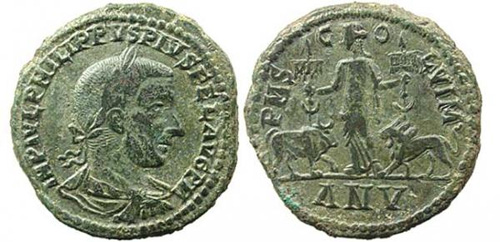 |
Weight: 21,56 grams Diameter: 31 mm |
Obverse: Bust of Philip I to the right with laurel wreath, part of paludamentum (cloak, cape) visible on the shoulder worn over armoured breast plate. Text: (A:) IMP IVL PHILIPPVS PIVS FEL AVG PM (IMPERATOR IVLIVS PHILIPPVS PIVS FELIX AVGVSTVS PERSICVS MAXIMVS) - Emperor Iulius Philippus dutiful and fortunate Augustus, greatest conquerer of the Persians. Reverse: Woman (Moesia) standing with head to the left. On her left side a bull and on her right side a lion. In her hands she is holding two army standards. The left one is inscribed with the Roman numeral VII. The right one is inscribed with the roman numeral IIII. Text: (c:) PMS - C - O - LVIM (PROVINCIA MOESIA SVPERIOR COLONIA VIMINACIVM) - Province Moesia Superior Colony Viminacium. Exergue: AN V (ANNO V) - year 5 (243/244). Remark: The obverse has the first type of legend wich ends with PM of Persicus Maximus. Later this title was removed from the coins because the victory over the Persians was bought at a high cost. The portrait of Philip on this coin still has some of the looks of Gordian III because the die cutters did not yet knew what the emperor looked like. |
|
| Sestertius ANNO V - 243/244 - Pick 100 - Martin 2.09.1 - Varbanov 132 | |
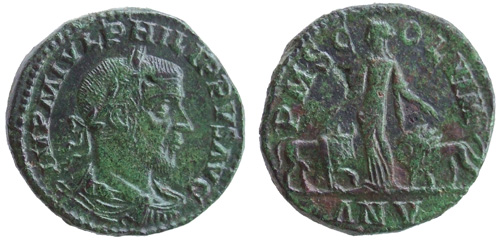 |
Private collection Weight: 17,92 grams |
Obverse: Bust of Philip I to the right with laurel wreath, part of paludamentum (cloak, cape) visible on the shoulder worn over armoured breast plate. Text: (C:) IMP M IVL PHILIPPVS AVG (IMPERATOR MARCVS IVLIVS PHILIPPVS AVGVSTVS) - Emperor Marcus Iulius Philippus Augustus. Reverse: Woman (Moesia) standing with head to the left holding her right hand over a bull and her left hand over a lion. Text: (b:) PMSC - OLVIM (PROVINCIA MOESIA SVPERIOR COLONIA VIMINACIVM) - Province Moesia Superior Colony Viminacium. Exergue: AN V (ANNO V) - year 5 (243/244). Opmerking: This sestertius looks likes an in between type from the year 5. The legend is of the shorter version, a letter M of Marcus is inserted but the text Pius Felix and Persicus Maximus is left out. The portrait of Philip on this coin still has some of the looks of Gordian III. |
|
| Sestertius ANNO V - 243/244 - Pick 100 var. - Martin 2.09.1 - Varbanov 132 | |
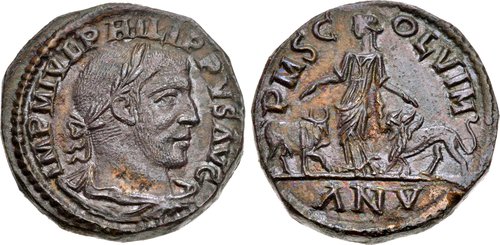 |
Copyright Classical Numismatic Group Weight: 20,11 gram |
Obverse: Bust of Philip I to the right with laurel wreath, part of paludamentum (cloak, cape) visible on the shoulder worn over armoured breast plate. Text: (C:) IMP M IVL PHILIPPVS AVG (IMPERATOR MARCVS IVLIVS PHILIPPVS AVGVSTVS) - Emperor Marcus Iulius Philippus Augustus. Reverse: Woman (Moesia) standing with head to the left holding her right hand over a bull and her left hand over a lion. Text: (b:) PMSC - OLVIM (PROVINCIA MOESIA SVPERIOR COLONIA VIMINACIVM) - Province Moesia Superior Colony Viminacium. Exergue: AN V (ANNO V) - year 5 (243/244). Remark: This sestertius is from a later date in the year 5. The legend is of the shorter version, a letter M of Marcus is inserted but the text Pius Felix and Persicus Maximus is left out. The portrait looks more like that of Philip and like that on his later coins. |
|
AN VI |
|
| Sestertius ANNO VI - 244/245 - Pick 102 - Martin 2.12.1 - Varbanov 135 | |
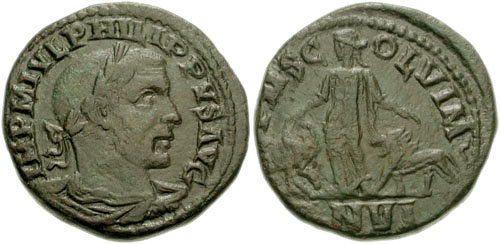 |
Copyright Classical Numismatic Group Weight: 20,92 gram |
Obverse: Bust of Philip I to the right with laurel wreath, part of paludamentum (cloak, cape) visible on the shoulder worn over armoured breast plate. Text: (C:) IMP M IVL PHILIPPVS AVG (IMPERATOR MARCVS IVLIVS PHILIPPVS AVGVSTVS) - Emperor Marcus Iulius Philippus Augustus. Reverse: Woman (Moesia) standing with head to the left holding her right hand over a bull and her left hand over a lion. Text: (b:) PMSC - OLVIM (PROVINCIA MOESIA SVPERIOR COLONIA VIMINACIVM) - Province Moesia Superior Colony Viminacium. Exergue: AN VI (ANNO VI) - year 6 (244/245). Remark: Early year 6 sestertius. The portrait looks like the one on the last year 5 sestertii. |
|
| Sestertius ANNO VI - 244/245 - Pick 102 - Martin 2.12.1 - Varbanov 135 | |
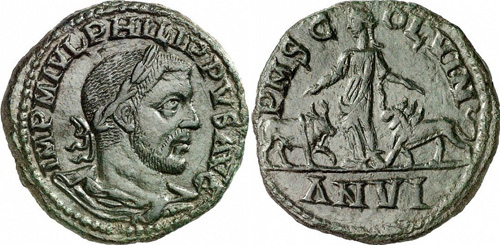 |
Weight: 16,81 grams Diameter: ? mm |
Obverse: Bust of Philip I to the right with laurel wreath, part of paludamentum (cloak, cape) visible on the shoulder worn over armoured breast plate. Text: (C:) IMP M IVL PHILIPPVS AVG (IMPERATOR MARCVS IVLIVS PHILIPPVS AVGVSTVS) - Emperor Marcus Iulius Philippus Augustus. Reverse: Woman (Moesia) standing with head to the left holding her right hand over a bull and her left hand over a lion. Text: (b:) PMSC - OLVIM (PROVINCIA MOESIA SVPERIOR COLONIA VIMINACIVM) - Province Moesia Superior Colony Viminacium. Exergue: AN VI (ANNO VI) - year 6 (244/245). Remark: Later year 6 sestertius. |
|
| Sestertius ANNO VI - 244/245 - Pick 102 - Martin 2.12.1 - Varbanov 135 | |
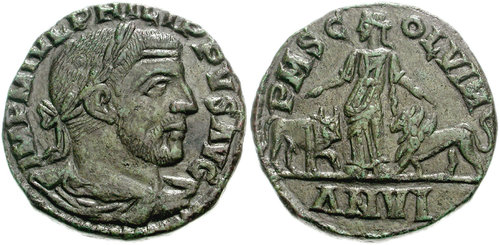 |
Copyright Classical Numismatic Group Weight: 17,49 gram |
Obverse: Bust of Philip I to the right with laurel wreath, part of paludamentum (cloak, cape) visible on the shoulder worn over armoured breast plate. Text: (C:) IMP M IVL PHILIPPVS AVG (IMPERATOR MARCVS IVLIVS PHILIPPVS AVGVSTVS) - Emperor Marcus Iulius Philippus Augustus. Reverse: Woman (Moesia) standing with head to the left holding her right hand over a bull and her left hand over a lion. Text: (b:) PMSC - OLVIM (PROVINCIA MOESIA SVPERIOR COLONIA VIMINACIVM) - Province Moesia Superior Colony Viminacium. Exergue: AN VI (ANNO VI) - year 6 (244/245). Remark: Later year 6 sestertius. Bigger portrait of Philip. |
|
AN VII |
|
| Sestertius ANNO VII - 245/246 - Pick 103 - Martin 2.14.1 - Varbanov 136 | |
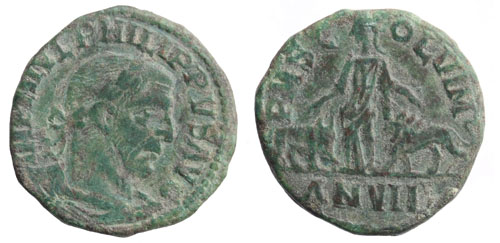 |
Private collection Weight: 16,60 grams Diameter: 27,7 mm |
Obverse: Bust of Philip I to the right with laurel wreath, part of paludamentum (cloak, cape) visible on the shoulder worn over armoured breast plate. Text: (C:) IMP M IVL PHILIPPVS AVG (IMPERATOR MARCVS IVLIVS PHILIPPVS AVGVSTVS) - Emperor Marcus Iulius Philippus Augustus. Reverse: Woman (Moesia) standing with head to the left holding her right hand over a bull and her left hand over a lion. Text: (b:) PMSC - OLVIM (PROVINCIA MOESIA SVPERIOR COLONIA VIMINACIVM) - Province Moesia Superior Colony Viminacium. Exergue: AN VII (ANNO VII) - year 7 (245/246). |
|
AN VIII |
|
| Sestertius ANNO VIII - 246/247 - Pick 104 - Martin 2.16.1 - Varbanov 137 | |
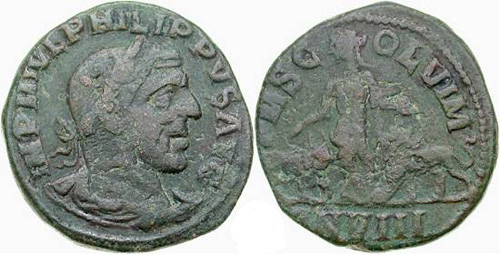 |
Private collection Weight: 14,00 grams Diameter: 27,0 mm |
Obverse: Bust of Philip I to the right with laurel wreath, part of paludamentum (cloak, cape) visible on the shoulder worn over armoured breast plate. Text: (C:) IMP M IVL PHILIPPVS AVG (IMPERATOR MARCVS IVLIVS PHILIPPVS AVGVSTVS) - Emperor Marcus Iulius Philippus Augustus. Reverse: Woman (Moesia) standing with head to the left holding her right hand over a bull and her left hand over a lion. Text: (b:) PMSC - OLVIM (PROVINCIA MOESIA SVPERIOR COLONIA VIMINACIVM) - Province Moesia Superior Colony Viminacium. Exergue: AN VIII (ANNO VIII) - year 8 (246/247). |
|
AN VIIII |
|
| Dupondius ANNO VIIII - 247/248 - Pick 94 - Martin 2.03.1 - Varbanov - | |
 |
Weight: 3 grams Diameter: 21 mm |
Obverse: Bust of Philip I to the right with radiate crown, part of paludamentum (cloak, cape) visible on the shoulder worn over armoured breast plate. Text: (D:) IMP PHILIPPVS AVG (IMPERATOR PHILIPPVS AVGVSTVS) - Emperor Philippus Augustus. Reverse: Woman (Moesia) standing with head to the left holding her right hand over a bull and her left hand over a lion. Text: (b:) PMSC - OLVIM (PROVINCIA MOESIA SVPERIOR COLONIA VIMINACIVM) - Province Moesia Superior Colony Viminacium. Exergue: AN (VIII or VIIII) (ANNO VIII or VIIII) - year 8 or 9 (246/247 or 247/248) |
|
| Sestertius ANNO VIIII - 247/248 - Pick 105 - Martin 2.17.1 - Varbanov 138 | |
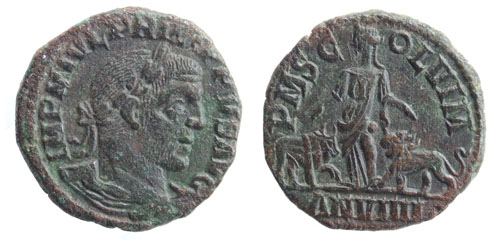 |
Private collection Weight: 15,74 grams Diameter: 27,7 mm |
Obverse: Bust of Philip I to the right with laurel wreath, part of paludamentum (cloak, cape) visible on the shoulder worn over armoured breast plate. Text: (C:) IMP M IVL PHILIPPVS AVG (IMPERATOR MARCVS IVLIVS PHILIPPVS AVGVSTVS) - Emperor Marcus Iulius Philippus Augustus. Reverse: Woman (Moesia) standing with head to the left holding her right hand over a bull and her left hand over a lion. Text: (b:) PMSC - OLVIM (PROVINCIA MOESIA SVPERIOR COLONIA VIMINACIVM) - Province Moesia Superior Colony Viminacium. Exergue: AN VIIII (ANNO VIIII) - year 9 (247/248). |
|
AN XI |
|
| Sestertius ANNO XI - juli 249 - augustus 249 - Pick 108 - Martin 2.34.2 - Varbanov 161 | |
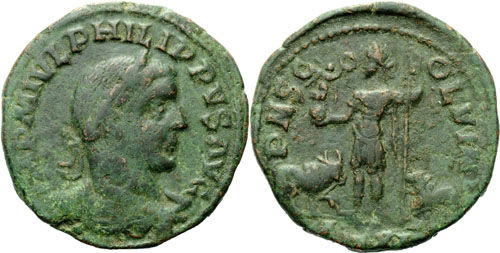 |
Private collection Weight: ? grams Diameter: ? mm |
Obverse: Bust of Philip I to the right with laurel wreath, part of paludamentum (cloak, cape) visible on the shoulder worn over armoured breast plate. Text: (C:) IMP M IVL PHILIPPVS AVG (IMPERATOR MARCVS IVLIVS PHILIPPVS AVGVSTVS) - Emperor Marcus Iulius Philippus Augustus. Reverse: Philip standing to the left between a bull (left) and a lion (right). In his left hand he hold a spear and on his right hand a globe. On the globe stands a small figure of Victoria who is presenting a laurel wreath tot the emperor. Text: (b:) PMSC - OLVIM (PROVINCIA MOESIA SVPERIOR COLONIA VIMINACIVM) - Province Moesia Superior Colony Viminacium. Exergue: AN XI (ANNO XI) - year 11 (249/250) Remark: To me it is not completely clear in whose name this coin was struck. It could be a coin in the name of Philip I or his son Philip II. The titles of both emperors as Augustus are identical. An attribution to one of them is often done by looking at the coin portrait. Coins with the portrait of a child or a young man are attributed to Philip II where coins with a portrait of an older man are attributed to his father Philip I. This coin type from the year XI was probably struck during the period july/august 249 when the regime of Philip was re-instated for a short while in Moesia Superior. |
|
| Sestertius ANNO XI - juli 249 - augustus 249 - Pick 108 var. - Martin 2.34.1 - Varbanov 161 | |
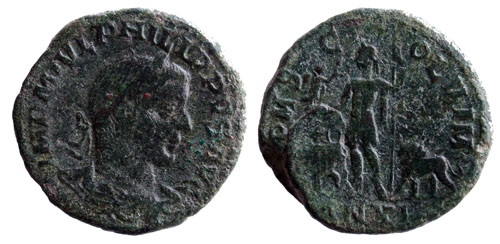 |
Private collection Weight: 14,68 grams Diameter: 28 mm |
Obverse: Bust of Philip I to the right with laurel wreath, part of paludamentum (cloak, cape) visible on the shoulder worn over armoured breast plate. Text: (C:) IMP M IVL PHILIPPVS AVG (IMPERATOR MARCVS IVLIVS PHILIPPVS AVGVSTVS) - Emperor Marcus Iulius Philippus Augustus. Reverse: Philip standing to the left between a bull (left) and a lion (right). In his left hand he hold a spear and on his right hand a globe. On the globe stands a small figure of Victoria who is presenting a laurel wreath tot the emperor. Text: (a:) PMS - C - OLVIM (PROVINCIA MOESIA SVPERIOR COLONIA VIMINACIVM) - Province Moesia Superior Colony Viminacium. Exergue: AN XI (ANNO XI) - jaar 11 (249/250) Remark: To me it is not completely clear in whose name this coin was struck. It could be a coin in the name of Philip I or his son Philip II. The titles of both emperors as Augustus are identical. An attribution to one of them is often done by looking at the coin portrait. Coins with the portrait of a child or a young man are attributed to Philip II where coins with a portrait of an older man are attributed to his father Philip I. This coin type from the year XI was probably struck during the period july/august 249 when the regime of Philip was re-instated for a short while in Moesia Superior. |
|
| Sestertius ANNO XI - juli 249 - augustus 249 - Pick 106 - Martin 2.18.1 - Varbanov - (Verg. 160) | |
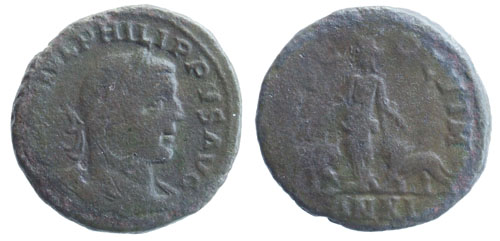 |
Private collection Weight: 15,77 grams Diameter: 29,46 mm |
Obverse: Bust of Philip I to the right with laurel wreath, part of paludamentum (cloak, cape) visible on the shoulder worn over armoured breast plate. Text: (C:) IMP M IVL PHILIPPVS AVG (IMPERATOR MARCVS IVLIVS PHILIPPVS AVGVSTVS) - Emperor Marcus Iulius Philippus Augustus. Reverse: Woman (Moesia) standing with head to the left holding her right hand over a bull and her left hand over a lion. Text: (b:) PMSC - OLVIM (PROVINCIA MOESIA SVPERIOR COLONIA VIMINACIVM) - Province Moesia Superior Colony Viminacium. Exergue: AN XI (ANNO XI) - year 11 (juli 249 - august 249). |
|